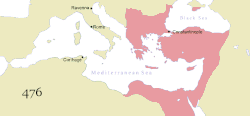
Back الإمبراطورية البيزنطية تحت حكم السلالتين القسطنطينية والفالنتينية Arabic Βυζαντινή Αυτοκρατορία υπό τις Δυναστείες Κωνσταντίνου και Βαλεντινιανού Greek امپراتوری بیزانس تحت خاندان کنستانتین و والنتینیان Persian Impero bizantino durante le dinastie costantiniana e valentiniana Italian 콘스탄티누스와 발렌티니아누스 왕조 치하의 동로마 제국 Korean Império Bizantino sob as dinastias constantina e valentiniana Portuguese قسطنطینی اور والنتینیانی شاہی سلاسل کے تحت بازنطینی سلطنت Urdu
Roman Empire
| |||||||||
|---|---|---|---|---|---|---|---|---|---|
| 324–379 | |||||||||
Chi Rho (see Byzantine insignia)
| |||||||||
 The territory of the Eastern Roman Empire, with the Western Roman Empire depicted in pink. | |||||||||
| Capital | Constantinople | ||||||||
| Common languages | Latin, Greek | ||||||||
| Demonym(s) | Roman | ||||||||
| Government | Monarchy | ||||||||
| Emperor | |||||||||
• 324–337 | Constantine I | ||||||||
• 337–361 | Constantius II | ||||||||
• 361–363 | Julian | ||||||||
• 363–364 | Jovian | ||||||||
• 364 | Valentinian I | ||||||||
• 364–378 | Valens | ||||||||
• 378–379 | Gratian | ||||||||
| History | |||||||||
| 19 September 324 | |||||||||
• coronation of Theodosius I as Emperor of the East | 19 January 379 | ||||||||
| |||||||||
The Eastern Roman Empire under the Constantinian and Valentinian dynasties was the earliest period of the Byzantine history that saw a shift in government from Rome in the West to Constantinople in the East within the Roman Empire under emperor Constantine the Great and his successors. Constantinople, formally named Nova Roma, was founded in the city of Byzantium (Ancient Greek: Βυζάντιον, romanized: Byzántion), which is the origin of the historiographical name for the Eastern Empire, which self-identified simply as the "Roman Empire".
| History of the Byzantine Empire |
|---|
 |
| Preceding |
| Early period (330–717) |
| Middle period (717–1204) |
| Late period (1204–1453) |
| Timeline |
| By topic |
|
|
- ^ A. Macgeorge, Flags, Glasgow (1881): The labarum of the emperors [...] frequently bore upon it a representation of the emperor, sometimes by himself and sometimes accompanied by the heads of members of his family."

